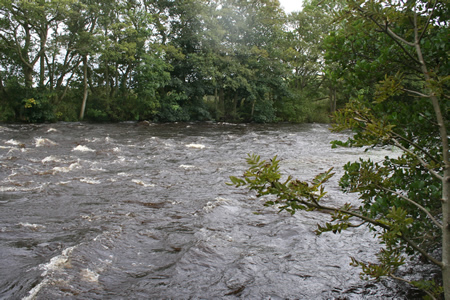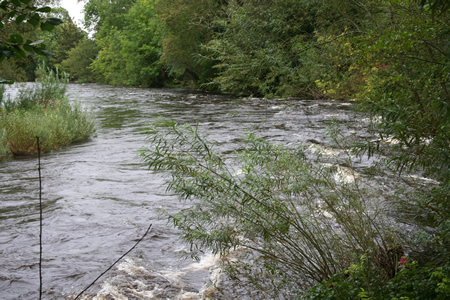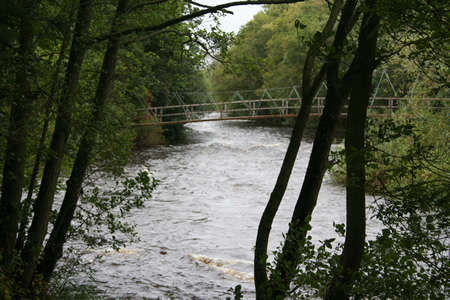These bulletin blogs represent news about Finavon and the South Esk, and my views as a riparian owner. They are not the views of any other organisation, nor are they designed to promote the interests of any individual or organisation other than Finavon Castle Water and factors affecting the fishery. Tony Andrews
The weather turned really foul today (16/9) and, as I write this, there’s a howling gale and heavy rain which has been building all day. Andrew Robertson and I fished both Milton and Bogardo Beats today. We saw plenty of fish but caught nothing, despite some hefty pulls from salmon in Bridge Pool and Marcus House Pool. Our impression, having observed fish splashing around on both beats, is that there are plenty of fish, especially in the Boat Pool. The river hasn’t started to rise yet, although it undoubtedly will later on, and conditions have been just about perfect with slightly tinged water still fining down after the spate we had earlier in the week. Salmon are still running, and there is a good percentage of fresh fish in all the pools, but, so typical of September, really hard to catch.
This is the head of Flats in a good September spate (13/9/2011). A place to catch a spring salmon or apply your best fieldcraft to winkle out a sea trout at dusk in low water. Flats is a nice variety feature of Milton Beat.
Earlier in the week we had some good fish to 12lbs, and I caught a coloured cock of about 9lbs in that perfect spot in Red Brae, just where the current deflects into the middle of the river at the end of the Wall. There really are few more alluring pools than Red Brae when the level of the river is lipping the lowest part of the Wall. Wading on fine gravel from the left bank (N) and casting your fly across into dark water under the Wall , and with the current drawing it steadily across the pool that becomes clearer and shallower closer to the north bank, is a fine fly fishing experience. One thing I have always felt about this pool is that it holds salmon in nearly every month of the year. I always look for an early season fish there, and in the records are some lovely fish in the high teens of lbs caught in late February and March. It can be awesome in a spate (see photo with this blog). I remember a number of occasions when there was a shoal of fish in the lie at the end of the Wall and two or three were caught before it went quiet again. In the pools descriptions of this website I recognise the importance of the Red Brae, but also what an awkward and capricious pool it can be. Some would call it dour, but Red Brae can be generous, and catching a salmon in that totally peaceful place is pure magic!
This is Red Brae in this week’s spate. The main current rushes along the Wall and continues to erode the red brae itself. At this height the pool is nearly unfishable except for a patch of calmer water close the the left bank downstream of the end of the Wall.
So where are we with this strange fishing season? A summary of catches might describe it as “good spring salmon, very few grilse, consistent MSW salmon catches throughout, and a river with a massive stock by early September”. In terms of the weather one might say, “good early season levels, followed by a late spring drought and then incessant rain and fluctuating levels”. So what does this tell us? I think there is not much doubt that this has been a good year for MSW salmon, with some big fish among them. The condition of these fish has been generally good, with the early season salmon in quite exceptionally good condition. Later in the season some MSW salmon have been less well nourished but, in my inexpert view, nothing to worry about. There have, as I say, been few grilse, and some of them very small and a few pitifully thin.
This is the view looking upstream from Red Brae hut during this week’s spate. the pool in the foreground is Craigo Stream, which doesn’t fish at all in a spate, but it can be a fine low water cast.
As far as the South Esk sea trout are concerned I believe that high water levels prevented them shoaling in the pools, as they tend to do in a normal summer. For example, we never saw really big shoals of school sea trout averaging 2lbs 8oz in the main pools, although for a brief period there were groups of sea trout in Indies, Melgund, Haughs and Boat Pool/Willows. My guess, and that’s what it is, but at least it is based on regular observation, is that the sea trout stocks of the South Esk are healthy, sustainable, but certainly not in the upper range of historical abundance. Condition of individual sea trout has been generally excellent, indicating that the fish we saw had access to good feeding at sea. As far as the restraint that George Pullar has exercised in returning net caught sea trout (for a compensation payment) this will undoubtedly have helped maintain the stocks at a sustainable level. Conservation of sea trout has been widely supported by anglers returning fish alive to the river. One last point on sea trout is that September has seen a late flurry of catches at Kinnaird and Finavon. While these fish may have dropped downriver after the main run in June and July, I think it more likely that these are genuine late-running sea trout. That is a tendency which should help spread the spawning stock throughout the catchment, because many of these late sea trout may choose to spawn in the main stem of the river, for example, in the gravel of Willows and Indies Pools.
My apologies to FCW blog readers for the erratic posting in recent weeks. We have now solved the problem by updating the software.
TA


